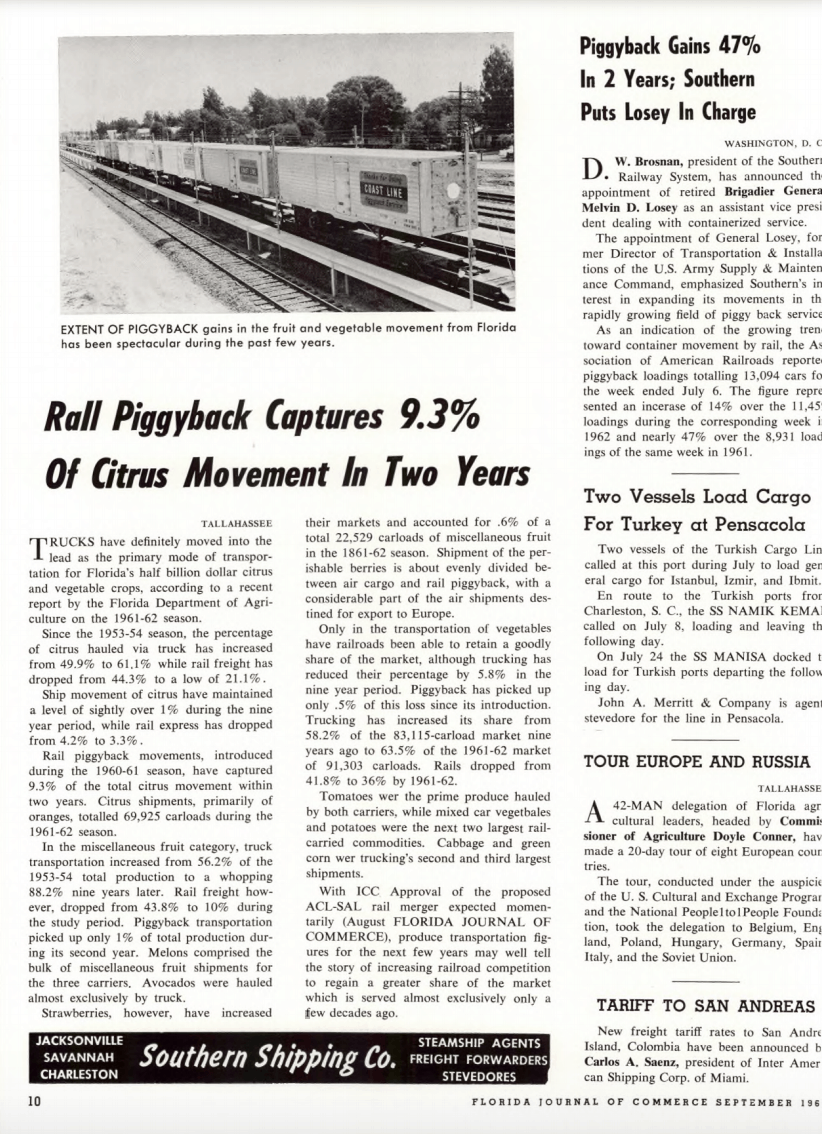The many industries that make up the world of freight have undergone tremendous change over the past several decades. Each Friday, FreightWaves explores the archives of American Shipper’s nearly 70-year-old collection of shipping and maritime publications to showcase interesting freight stories of long ago.
The following is an excerpt from the September 1963 edition of the Florida Journal of Commerce.
Trucks have definitely moved into the lead as the primary mode of transportation for Florida’s half billion dollar citrus and vegetable crops, according to a recent report by the Florida Department of Agriculture on the 1961-62 season.
Since the 1953-54 season, the percentage of citrus hauled by truck has increased from 49.9% to 61.1% while rail freight has dropped from 44.3% to a low of 21.1%. Ship movements of citrus have maintained a level of slightly over 1% during the nine-year period, while rail express has dropped from 4.2% to 3.3%.
Rail piggyback movements, introduced during the 1960-61 season, have captured 9.3% of the total citrus movement within two years. Citrus shipments, primarily of oranges, totaled 69,925 carloads during the 1961-62 season.
In the miscellaneous fruit category, truck transportation increased from 56.2% of the 1953-54 total production to a whopping 88.2% nine years later. Rail freight, however, dropped from 43.8% to 10% during the study period. Piggyback transportation picked up only 1% of total production during its second year. Melons comprised the bulk of miscellaneous fruit shipments for the three carriers. Avocados were hauled almost exclusively by truck.
Strawberries, however, have increased their markets and accounted for 0.6% of a total 22,529 carloads of miscellaneous fruit in the 1961-62 season. Shipment of the perishable berries is about evenly divided between air cargo and rail piggyback, with a considerable part of the air shipments destined for export to Europe.
Only in the transportation of vegetables have railroads been able to retain a goodly share of the market, although trucking has reduced their percentage by 5.8% in the nine-year period. Piggyback has picked up only 0.5% of this loss since its introduction. Trucking has increased its share from 58.2% of the 83,115-carload market nine years ago to 63.5% of the 1961-62 market of 91,303 carloads. Rail has dropped from 41.8% to 36% by 1961-62.
Tomatoes were the prime produce hauled by both carriers, while mixed car vegetables and potatoes were the next two largest rail-carried commodities. Cabbage and green corn were trucking’s second and third largest shipments.
With ICC approval of the proposed ACL-SAL rail merger expected momentarily (August Florida Journal of Commerce), produce transportation figures for the next few years may very well tell the story of increasing railroad competition to regain a greater share of the market which served almost exclusively only a few decades ago.

You may also like:
FreightWaves Flashback 1960: “Walk-Through” Containers Give Maximum Flexibility
FreightWaves Flashback 1963: Airplane displaces ship in Saturn S-IV transportation role
FreightWaves Flashback 1963: Rail piggyback captures 9.3% of citrus movement in two years







